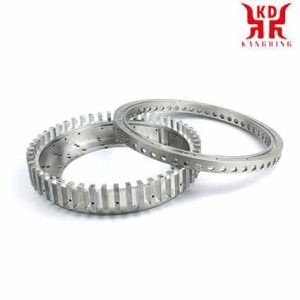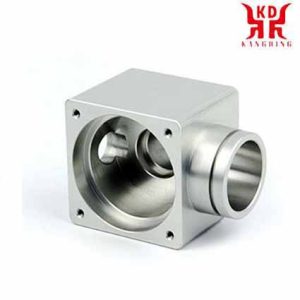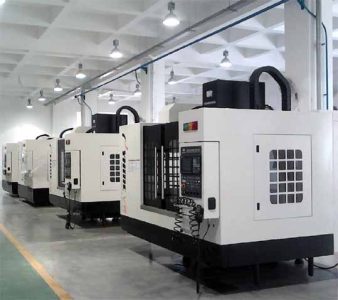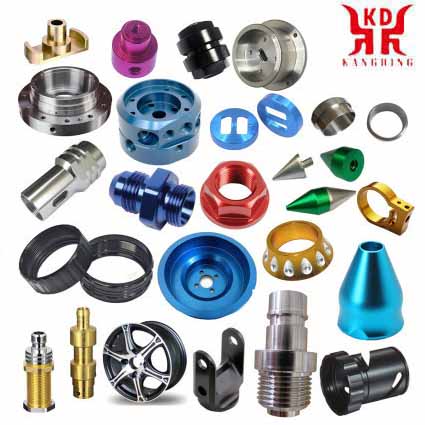Frezeleme nedir? Frezeleme işlemi nedir? CNC frezeleme ile hangi parçalar işlenebilir?? Çin değirmen parçaları hangi hassasiyete ulaşabilir??

Frezeleme nedir?
CNC frezelenmiş parçalar
CNC frezelenmiş parçalar nasıl üretilir??
CNC frezeleme parçaları CNC freze tezgahlarında dönen takımlar yardımıyla işlenir. Farklı hareket serbestliği derecelerine sahip CNC freze makineleri kullanılmaktadır: 3-eksen, 4-eksenli ve 5 eksenli freze makineleri.
3-axis milling machines can only machine CNC milled parts from one accessibility direction. They are cheaper than the other types of milling machines. 4-axis milling machines have an additional axis of rotation for the milled part, for example for the production of spindles and other helical geometries. 5-axis milling machines can machine CNC milled parts from all sides, depending on the clamping, and also produce complex geometries.
With our supplier network, we can manufacture a wide range of CNC milled parts for a wide variety of requirements.
We specialize in CNC machining, our automatic price calculation is constantly being expanded and currently covers components with the following properties.
Milling consists mainly of cutting the material that is machined with a rotary tool with several edges, called teeth, lips or carbide inserts, which executes programmed advance movements of the worktable in almost any direction of the three Possible axes on which the table where the part to be machined is fixed can be moved.
Sayısal kontrollü freze makinelerinin kullanımının artmasıyla birlikte, bu tip makinelerle yapılabilecek frezeleme işlemleri artıyor, ve böylece frezeleme çok amaçlı bir işleme yöntemi haline geldi. Takımların geliştirilmesi, verimliliği önemli ölçüde artırmanın yanı sıra yeni frezeleme olanaklarının yaratılmasına da katkıda bulundu., gerçekleştirilen operasyonların kalitesi ve doğruluğu.
| CNC frezelenmiş parçalar için üretim seçeneklerimiz
Bileşen boyutları 2 mm x 2 mm x 2 mm |

cnc freze parçaları
Freze takımları
Freze takımları dış çaplarıyla karakterize edilir, diş sayısı, dişlerin aralığı (ardışık iki diş arasındaki mesafe olarak anlaşılır) ve kesicinin makineye sabitleme sistemi.
Frezeleme türleri
Uygun aksesuarların kullanıldığı üniversal freze makinelerinde veya sayısal kontrollü freze makinelerinde aşağıdaki Planlama yapılabilir:.
Frezelemenin en sık uygulaması düz yüzeyler elde etmeyi amaçlayan yüzey frezelemedir. Yüzey frezeleme için genellikle değiştirilebilir karbür uçlara sahip frezeleme takımları kullanılır, bu frezelerin çapları ve her birinin taktığı kesici uç sayısı çok çeşitlidir. freze kesicisi bağlantıları. Insert manufacturers recommend as a first option the use of round inserts or with 45º angles as an alternative.
Square milling. Square milling is a variant of face milling that consists of leaving perpendicular steps in the part to be machined. Bunun için, square inserts are used that are located in the tool holder in an appropriate way.
Cube Milling. The cubing operation is very common in vertical or horizontal milling machines and consists of preparing the metal dowels or other material such as marble or granite in the appropriate cubic dimensions for subsequent operations. This milling is also done with interchangeable insert face milling cutters.

cnc freze parçaları Freze çeşitleri
Cut milling. Çoğunlukla gerçekleştirilmesi gereken ilk işleme operasyonlarından biri, ticari çubuklardan ve daha büyük uzunluktaki profillerden başlayarak parçaların belirlenen uzunlukta kesilmesinden oluşur.. Parçaların endüstriyel kesimi için silindirik kesicilerle donatılmış şerit testereler veya freze makineleri birbirinin yerine kullanılır. Frezlerin kesilmesinde önemli olan, yüksek hız çeliğinden veya sert metalden yapılabilmesidir.. Çok ince olmaları ile karakterize edilirler (sıra içinde 3 mm, değişiklik gösterse de), büyük çapa ve çok ince dişlere sahip olmak. Bir kesicinin özelliklerine bir örnek aşağıdaki gibi olabilir: çapı 200 mm, kalınlığı 3 mm, deliğin çapı 32 mm ve 128 dişler: İyi 128, Kaba 64.
Düz Kanal Açma Frezeleme. Düz kanalları frezelemek için, Genellikle oluk genişliğine sahip silindirik kesiciler kullanılır ve sıklıkla, to increase production, several cutters are mounted on the cutter shaft allowing to increase machining productivity. The assembly of several cylindrical strawberries is called a train of strawberries or compound strawberries. Cylindrical burs are characterized by having three cutting edges: the front and the two sides. High speed steel burs are used in most applications since carbide burs are very expensive and are therefore only used in very large productions.

cnc freze parçaları Freze çeşitleri
Shape grooving.. Burs of the appropriate shape for the groove are used, which can be T-shaped, dovetail, vesaire.
Keyway grooving. Cylindrical strawberries with handles, known in slang as ballerinas, are used that can cut both in a direction perpendicular to its axis and parallel to it.
Milling in Copying. Orografilerde ve değişen yüz profillerinde işleme operasyonlarının gerçekleştirilebilmesi için kopya frezelemede yuvarlak kesici uçlu profil kesiciler kullanılır.. İki tür kopya kesici vardır: yarım küre profilli olanlar ve yuvarlak veya torik kenarlı olanlar.
Boşluk frezeleme. Bu tip operasyonda, önceden bir delme işlemi yapılması ve oradan uygun frezeleme takımları ile yapılması tavsiye edilir., boşluk işlemeye yaklaşma, boşluğun yarıçapının en az olması gerektiğini akılda tutarak 15% freze bıçağının yarıçapından daha büyük.
Torna-freze. Bu tür işleme, sayısal kontrollü freze makinelerinde dairesel enterpolasyon kullanır ve hem hassas delik tornalama hem de dış tornalama için kullanılır. İşlem, iş parçasının ve freze takımının dönüşünü birleştirir, making it possible to achieve a cylindrical surface. This surface can be concentric with respect to the center line of rotation of the part, or it can be eccentric if the milling is moved up or down. With axial displacement it is possible to achieve the required length.
Thread milling. Thread milling requires a milling machine capable of simultaneous helical interpolation in two degrees of freedom: the rotation of the part with respect to the axis of the helix of the thread and the translation of the part in the direction of said axis.
Yüz frezeleme. It consists of milling that is carried out with cylindrical helical burs that attack the milling operation frontally. More and more fully integral carbide burs are used in numerical control milling machines that allow working at very high speeds.
Gear milling. Gear milling is hardly carried out on universal milling machines using the dividing plate anymore, but is done on special machines called gear hobbing machines and with the use of special milling cutters of the appropriate tooth module.
Sondaj, reaming and boring. These operations are usually carried out on numerical control milling machines equipped with a tool magazine and using the appropriate tools for each case.
Mortising. It consists of machining keyways in the holes, for which broaching machines are used or a special accessory that is attached to the universal milling machine head and transforms the rotation movement into an alternative vertical movement.
Ramp milling. It is a common type of milling in the machining of molds that is done either with copier milling machines or with numerical control milling cutters.
CNC freze makinesi nasıl çalışır??
Bilgisayarlı sayısal kontrolün tanıtılması (CNC) has exponentially expanded the applications of industrial machines through the programmable automation of production and the achievement of movements impossible to carry out manually, daireler gibi, diagonal lines and other more complicated figures that allow the manufacture of parts with highly complex profiles. Bu aynı zamanda herhangi bir üretim prosesindeki birçok temel değişkenin optimizasyonu anlamına da gelir: üretkenlik, kesinlik, emniyet, hız, tekrarlanabilirlik, esneklik ve atıkların azaltılması.
Bugün var olan frezeleme makinelerinin çokluğu, CNC donanımlı emsallerinin çoğalmasına kadar rahat bir şekilde genişledi. Aslında, eski freze makinelerini CNC freze makinesine dönüştürmek için özel kitler de bulunmaktadır.
Temel olarak, CNC freze makineleri geleneksel olanlara çok benzer ve aynı hareketli parçalara sahiptir, yani, masa, kesme kafası, iş mili ve yan ve çapraz kızak taşıyıcıları. Fakat, bu hareketli parçaları çalıştırmak için kolları veya krankları yoktur, daha ziyade, kontrollerle dolu bir panele yerleştirilmiş bir ekran ve yaptıkları işin aynısını yapacak motorların çalışmasını düzenleyen elektrikli ve elektronik bileşenleri barındıran metal bir kutu.. eski makinelerin kolları ve krankları. Bu bileşenler arasında CNC bulunmaktadır., ilgili yazılım aracılığıyla freze makinesinin hareketlerinden sorumlu olan bir bilgisayardır. Elektronik ve tahrik motorları veya servo motorların kombinasyonu, mümkün olan tüm frezeleme işlemlerini gerçekleştirme kapasitesine sahiptir.
CNC tarafından uygulanan hareket kontrolünü anlamak, geleneksel bir freze makinesinin nasıl çalıştığını kısaca gözden geçireceğiz.
Şekil tipik bir freze makinesini şematize etmektedir. Bu tip makinelerde, kranklar hareketli parçaları manuel olarak çalıştırır, böylece kesici alet (freze) en az üç eksende doğrusal olarak hareket eder, bunlara ana eksenler denir:
X ekseni: parçanın sıkıştırma yüzeyine yatay ve paralel. Freze tablasının uzunlamasına yatay düzlemindeki hareketle ilişkilidir..
ve eksen: X ve Z eksenleriyle doğrudan yönlü bir üçyüzlü oluşturur. Freze tablasının yatay enine düzlemindeki hareketle ilişkilidir..
Z ekseni: kesicinin monte edildiği yer, kesme gücüne sahip olan ve kafanın imkanlarına göre farklı pozisyonlar alabilendir.. Makine kafasının dikey yer değiştirmesi ile ilişkilidir..
Freze makinesinin sabit bir masası varsa, bu üç hareket iş mili tarafından gerçekleştirilir.
Fakat, Daha karmaşık parçaların frezelenmesinin, yörüngesi yalnızca doğrusal olmayan daha fazla sayıda eksen gerektireceği açıktır., ama aynı zamanda döner. İşte bu noktada CNC kavramı devreye giriyor, Bağımsız olarak kontrol edilen ve döner tablaların hareketi ile belirlenen çok sayıda tamamlayıcı eksene yol açan ve / veya ayarlanabilir kafalar. Bu, parçanın farklı düzlemler ve yaklaşma açılarıyla işlenmesine olanak tanıyan çeşitli makine modellerinin ortaya çıkmasına neden olur..
Aşağıdaki şekilde temel bileşenleri ve ana parçalarıyla birlikte bir CNC freze makinesi örneğini görüyoruz. (X, e, Z) ve tamamlayıcı (B, W) eksenler.
1 – Kolon
2 – İş parçası
3 – Freze masası, X ve Y eksenlerinde hareketle
4 – Tornalama
5 – İş mili motoru dahil kesme kafası
6 – CNC kontrol paneli
7 – Soğutma sıvısı hortumları
X, e, Z – Seyahatin ana eksenleri
B – Kesme kafasının döner yer değiştirmesinin tamamlayıcı ekseni
W – Kesme kafasının uzunlamasına yer değiştirmesinin tamamlayıcı ekseni

cnc freze parçaları Freze çeşitleri
CNC'nin ana işlevi tablanın hareketlerini kontrol etmektir., enine ve boyuna taşıyıcılar ve / veya sayısal veriler aracılığıyla iş milini ilgili eksenleri boyunca. Fakat, hepsi bu değil, çünkü istenen nihai sonuca ulaşmak için bu hareketlerin kontrolü, her CNC işleminin parçası olan farklı cihazlar ve sistemler arasında mükemmel ayarlamayı ve doğru senkronizasyonu gerektirir.. Bunlar ana ve tamamlayıcı eksenleri içerir, iletim sistemi, iş parçası bağlama sistemleri ve takım değiştiriciler, bunların her biri, uygun şekilde şart koşulması gereken kendi yöntemlerini ve değişkenlerini sunar.
Bu sıkı kontrol, freze makinesiyle birlikte verilen ve CNC sayısal programlama dillerinden birini temel alan yazılım tarafından gerçekleştirilir., ISO gibi, HEIDENHAIN, Fagor, Fanuc, SINUMERIK ve Siemens. Bu yazılım sayılar içerir, harfler ve diğer semboller – Örneğin, G ve M kodları – Belirli bir görevi yerine getirebilecek bir öğretim programını tanımlamak için uygun formatta kodlanmış olan. G kodları makine hareket fonksiyonlarıdır (hızlı hareketler, beslemeler, radyal beslemeler, duraklamalar, döngüler), M kodları ise parçaların işlenmesi için gerekli olan çeşitli işlevlerdir, ama makine hareketi değil. (iş mili başlatma ve durdurma, takım değişikliği, soğutucu, programı durdurma, vesaire.). Bundan, bu tür bir makineyi çalıştırmak ve programlamak için geleneksel ekipmanlarla işleme operasyonlarına ilişkin temel bilgileri gerektirdiği sonucu çıkmaktadır., temel matematik bilgisi, ölçü aletlerinin teknik çizimi ve kullanımı.
Şu anda, the use of CAD (Bilgisayar destekli tasarım) ve CAM (bilgisayar destekli üretim) programs is an almost obligatory complement to any CNC machine, which is why, genel olarak, bir parçanın imalatı üç tür yazılımın birleşimini içerir:
CAD: parçanın tasarımını yapar.
KAM: parçanın işlenmesi için eksenlerin yer değiştirmelerini hesaplar ve ilerleme hızlarını toplar, dönüş hızları ve farklı kesici takımlar.
Kontrol yazılımı (makineye dahildir): CAM'dan talimatları alır ve freze makinesinin hareketli parçalarını bu talimatlara uygun olarak hareket ettirmek için emirleri yerine getirir..
Aşağıdaki video CAD kullanarak bir parçanın üretimini göstermektedir / KAM:
CNC freze makineleri profil frezeleme için özel olarak uyarlanmıştır, boşluklar, yüzey konturları ve kalıp kesme işlemleri, freze tezgahının iki veya üç ekseninin aynı anda kontrol edilmesi gereken. Rağmen, makinenin karmaşıklığına ve gerçekleştirilen programlamaya bağlı olarak, CNC freze makineleri otomatik olarak çalışabilir, kesicileri değiştirmek için genellikle bir operatöre ihtiyaç duyulur, iş parçalarının takılması ve sökülmesinin yanı sıra.
Rutin olarak CNC freze makinelerini kullanan endüstriler arasında otomotiv yer almaktadır. (motor bloklarının tasarımı, kalıplar, ve çeşitli bileşenler), havacılık (uçak türbinleri), ve elektronik (kalıp ve prototip oluşturma), makine imalatının yanı sıra, aletler ve elektrikli bileşenler.
 English
English العربية
العربية 中文(漢字)
中文(漢字) Čeština
Čeština Dansk
Dansk Nederlands
Nederlands Suomi
Suomi Français
Français Deutsch
Deutsch Italiano
Italiano 日本語
日本語 ಕನ್ನಡ
ಕನ್ನಡ 한국어
한국어 Português
Português Русский
Русский Slovenčina
Slovenčina Español
Español Svenska
Svenska Türkçe
Türkçe

